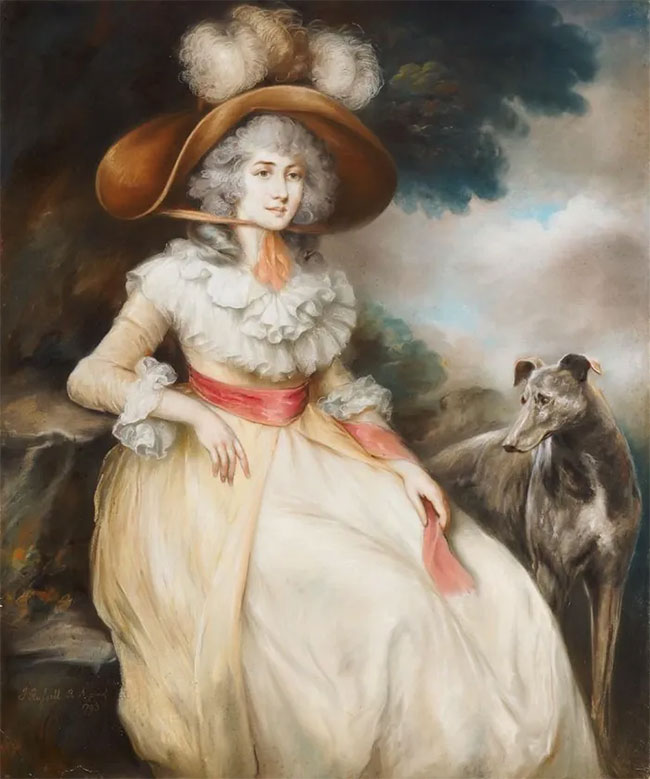Madame Lenormand (born in 1772) recognized her gift for card reading from a young age (a practice that emerged in Europe over 400 years prior). Throughout her life, she predicted the fates of many, including significant events and influential individuals. Her life took many turns, from studying at a convent school, becoming a fortune teller for the wealthy and famous, to imprisonment, publishing, and ultimately becoming a historical legend.
The Beginning of the Seer
On May 27, 1772, in the city of Alençon, located in the Normandy region of France, a remarkable baby girl was born. Upon delivering the baby, the midwife gasped in astonishment and fear upon seeing the child with long black hair and several teeth. News of this unusual newborn quickly spread, yet the child’s father did not abandon her, naming her Marie Anne Lenormand. Little did anyone know that she would later become one of the most influential seers and fortune tellers in France.
After the death of her mother and father, Lenormand was placed in a convent school at the age of five. Some surviving sources indicate that Lenormand predicted the abolition of the position of the Prioress at the Benedictine convent and even foretold her successor when she was just seven years old. This made her one of the most famous caricaturists in France, even to this day.
At the age of 14, Madame Lenormand set off for Paris. There, she honed her fortune-telling skills by studying a wide range of subjects (mathematics, astronomy, Greek and Roman spells, Druids, divination, Jewish Kabbalah, and astrology), becoming an expert in divinatory practices.
When Madame Lenormand turned seventeen, she began to tell fortunes professionally. With her skills, she opened a shop to formalize her fortune-telling career.
At this time, fortune-telling was illegal in France. Madame Lenormand officially opened a bookstore to circumvent government censorship. She was prepared to endure imprisonment as a result, which occurred in 1774, 1803, and 1809.
The first-person account by Captain RH Gronow in his book Famous People of London and Paris reveals: “It is unimaginable that a more grotesque creature could be formed. She looked like a grotesque toad, swollen and venomous with one eye a wall and the other a ring. She wore a fur hat on her head, glaring at her terrified guests from below. The walls of the room were covered with enormous bats, nailed by their wings to the ceiling, stuffed owls, mummified remains, skeletons – in short, everything that could impress a weak-minded or superstitious individual.”
Her first question, delivered in a deep voice, was whether you would have the grand or petit jeu, which was merely a matter of form. Then she would ask your age, your favorite color, and your preferred animal. Following that, “Coupez” was repeated in an authoritative tone, echoed at intervals until the required number of cards from different decks were selected and placed in adjacent rows.

Madame Lenormand.
Predictions for the Bonaparte Family
The close friendship between Josephine Bonaparte and Madame Lenormand began when both were imprisoned. At that time, Josephine was Josephine de Beauharnais, incarcerated with her husband and fearing imminent death. Upon hearing that Madame Lenormand was in the same prison, she desperately sought her assistance.
As a child, a fortune teller had told Josephine that she was destined for a favorable marriage. While waiting in prison for death, Josephine became particularly desperate when this prediction seemed to materialize. Madame Lenormand told Josephine that she would be released from prison, but her current husband would not, as he was destined for glory in a second marriage.
Four days later, Josephine was freed. Her husband had been executed. Two years after her release, Josephine married the French officer Napoleon Bonaparte. Following a coup in 1799, Napoleon became Emperor of France, and Josephine became Empress. During this time, Josephine and Madame Lenormand developed a close friendship.
To Madame Lenormand’s lament, she did not foresee the death of her dear friend. Josephine passed away unexpectedly in 1814, leaving Madame Lenormand devastated.
Napoleon disapproved of his wife’s interest in fortune-telling, particularly her relationship with Madame Lenormand. This was especially true when Madame Lenormand’s predictions concerned him. She made predictions about Napoleon’s divorce from Josephine (which occurred in 1809), his exile (rumored to have accurately predicted the date), and his death (in 1821).
Famous Predictions
While many admired and trusted her (including Tsar Alexander I of Russia), Madame Lenormand also faced skepticism. Three skeptics visited her one evening in 1792: Maximilien Robespierre, Louis Antoine de Saint-Just, and Jean-Paul Marat.
Not one to simply tell people what they wanted to hear, Madame Lenormand informed Robespierre, Saint-Just, and Marat that they would all die violent deaths.
Robespierre was the architect of the Reign of Terror in France. Two years after Madame Lenormand’s prediction, Robespierre was executed by guillotine at the age of 36, amid cheers from the crowd.
Saint-Just, at the age of 26, was also guillotined on the same day as Robespierre.
Despite his short life, Saint-Just left a powerful legacy. His proposals for voting rights, petitions, and equality directly informed the French Constitution of 1793.
Just before his death, he famously proclaimed regarding the Constitution, “I am the one who made this.”
Marat wore many hats. He was a political theorist, doctor, and scientist. He outlived his compatriots Robespierre and Saint-Just by many years. The violent death predicted by Madame Lenormand took 21 years to come to fruition.
As an influential figure during the French Revolution, he had many enemies. One evening while bathing, he was stabbed to death with a kitchen knife. The murderer,
Charlotte Corday, concealed the knife in her bodice and stabbed him in the chest. During her trial for his murder, she declared, “I killed a man to save 100,000.”
She passed away in 1843 at the age of 71. Dying without an heir, her belongings and assets were left to her nephew. A Catholic man, he refused to keep her mystical items, choosing instead to burn them all. However, his concern did not extend to her finances. He retained Madame Lenormand’s estate of 500,000 francs (worth approximately 5.3 million USD today).
Two years after her death, a deck of cards featuring Madame Lenormand was published. These cards have been recreated by many since then, using the name Lenormand. The oldest surviving Lenormand deck, dating back to the 1800s, can be viewed at the British Museum.
Madame Lenormand continues to generate interest even today. She was featured as a character in the 2014 video game Assassin’s Creed: Unity.
Her resting place remains a site of pilgrimage for enthusiasts. It is not uncommon to see flowers placed on her grave (Plot 3, Cimetière du Père Lachaise, Paris, Île-de-France, France).

















































